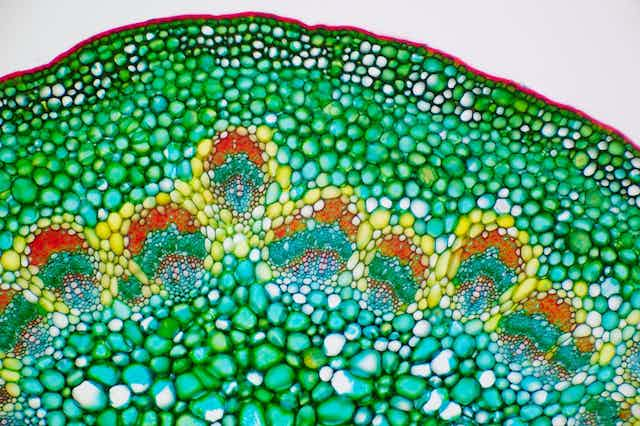Rapid developments in tools to study complex interactions are transforming biology and biomedical research.
A series of powerful analytical methods coined “omics” is driving us away from reductionist approaches towards a more systematic understanding of biology and disease.
Until recently, technical constraints have allowed researchers only to look at a small number of parts in biological systems. In contrast “omics” (such as genomics, proteomics, metabolomics) tries to look at the big picture to define a biological system.
One of these tools – metabolomics – detects the chemical fingerprint of a cell’s metabolism at unparallelled resolution. This fingerprint gives powerful insight into the dynamic processes taking place in all kinds of biological samples.
Every process in the cells of living organisms requires energy, and this energy is taken from nutrients as part of an organism’s metabolism. Biochemistry often involves determining the pathways nutrients or energy take in the cells of an organism.
Classically, this analysis was performed by measuring the activity of individual enzymes, or the levels of individual chemical compounds (metabolites) in a biological sample. This approach has provided some of the most profound insights into biology, but is time consuming and has its limits.
By contrast, metabolomics allows us to simultaneously measure the levels of hundreds or thousands of chemical compounds – an approach that gives us a much better overview of metabolism.
This power and versatility gives metabolomics wide-ranging use.
How does it work?
Metabolomics is made possible by two key bits of technology.
First, a complex mixture of small chemicals (metabolites) is extracted from a sample of cells, tissues, food, urine, microbial extract or anything you can think of. The next step, known as chromatography, reduces the chemicals into more simplified components.
Each metabolite in the mix is made up of a unique combination of chemical elements, which gives it a characteristic mass.
An incredibly sensitive instrument called a mass spectrometer is then used to detect these chemicals and measure their quantity. Modern mass spectrometers are able to measure the mass of very small amounts of metabolite down to the accuracy of a single hydrogen atom.

You can get some idea of just how accurate that is using this interactive biological scale. Almost at the very end of the zooming scale you can find the metabolites glucose and methionine and a carbon atom at the very end.
Recently metabolomics has become quite widely used in different areas of research. This rise in popularity was triggered by gains in sensitivity and speed of mass spectrometry.
Just as important were great advances in the data processing and analysis tools required for crunching the huge amounts of data generated. The emergence of the specialised field of bioinformatics allows us to take more than just an educated guess with the results. Innovations in computing facilitate this integration of “omics”, mathematics, statistics, systems, and biology. Bioinformatics has truly expanded our ability to understand what is going on inside cells, such as how genes and their products translate into a functional effect.
Why the big fuss?
In medicine, metabolomics is being used to discover new diagnostic markers for diseases like cancer and diabetes. Along the way we are getting fascinating new insights into how diseases develop and progress, understanding drug action, and pinpointing new targets for potential therapies.
For example, this American study used metabolomics analysis of urine to distinguish different stages of prostate cancer. The researchers measured 1,126 metabolites across 262 clinical samples. This gives some idea of the levels of detail provided.
In our lab at the Kinghorn Cancer Centre we are combining metabolomics with genomics (mapping gene mutations) in a brute force approach to better understand pancreatic cancer. This devastating disease is a significant killer, for which only few treatment options exist.

We have discovered that pancreatic tumours reprogram their metabolism to allow rapid cell division and growth. Our metabolomics data tell, and these pathways form a kind of Achilles heel for tumour cells that we hope to use to develop new treatments.
Metabolomics can also help us understand the effects of environmental conditions, pesticides, and pollutants. For example, exposure to hormone-mimicking birth control or anti-inflammatory compounds in sewage can cause gender-bending male fish to become feminised, even producing eggs.
Metabolomics is also used in quality control in food production, and can even distinguish how levels of nutrients change through processing of foods, for example processing semolina grain into wholemeal or refined pasta. There is great promise in using metabolomics to detect illicit use of hormones and drugs in livestock and athletic doping.
One of the more intriguing uses of metabolomics is in understanding the complex nature of wine. Huge effort is going into understanding how the interplay between soil, climate, yeast and bacteria in fermentation, and even the oak in barrels exert their effect on chemicals in grape juice to generate characteristic wine flavours and aromas.

In the real world – today and tomorrow
In disease studies, changes in metabolism offer up new ideas for cellular processes that can be treated by drugs, or can be used to find new ways to identify or specify diseases into more specific subgroups.
These discoveries have such wide reaching consequences as new targets for cancer therapies, detection methods for diabetes, better tasting cheese, more consistent batches of beer, more resilient crops, diagnostic tests for muscle wasting diseases of ageing, and more.
Another area where this technology could have a huge impact is in detection of contaminants in food (to verify claims to be organic or hormone-free), as well as doping in animals and athletes.
The advantage of metabolomics in detecting not only the molecule or drug of interest, but also their metabolic breakdown in various body fluids, provide promise in much more accurate screening.
Metabolomics is helping us explain how biological function is related to changes in the genome. This approach unveils the bigger picture when joining forces with the rest of the “omics” to link genetic variation with the effects we can see.

